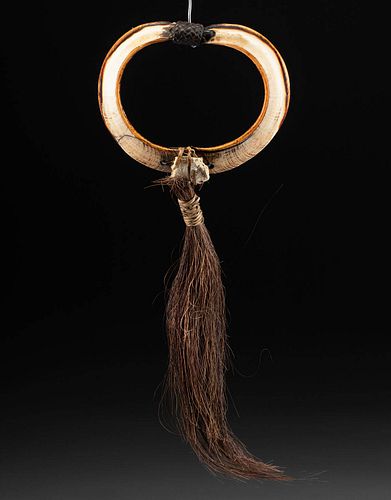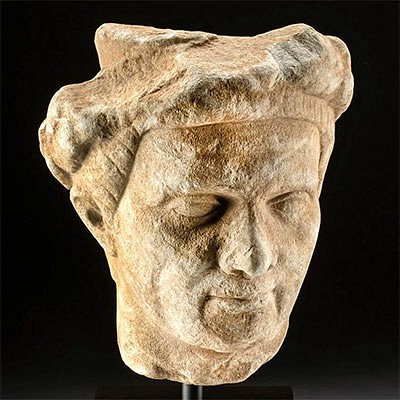Ifugao Boar Tusk & Hair Headhunter Tangkil Bracelet
Lot 191
About Seller
Artemis Fine Arts
686 S Taylor Ave, Ste 106
Louisville, CO 80027
United States
Selling antiquities, ancient and ethnographic art online since 1993, Artemis Gallery specializes in Classical Antiquities (Egyptian, Greek, Roman, Near Eastern), Asian, Pre-Columbian, African / Tribal / Oceanographic art. Our extensive inventory includes pottery, stone, metal, wood, glass and textil...Read more
Estimate:
$1,000 - $1,500
Absentee vs Live bid
Two ways to bid:
- Leave a max absentee bid and the platform will bid on your behalf up to your maximum bid during the live auction.
- Bid live during the auction and your bids will be submitted real-time to the auctioneer.
Bid Increments
| Price | Bid Increment |
|---|---|
| $0 | $25 |
| $300 | $50 |
| $1,000 | $100 |
| $2,000 | $250 |
| $5,000 | $500 |
| $10,000 | $1,000 |
| $20,000 | $2,500 |
| $50,000 | $5,000 |
| $100,000 | $10,000 |
| $200,000 | $20,000 |
About Auction
By Artemis Fine Arts
Jun 1, 2023
Set Reminder
2023-06-01 10:00:00
2023-06-01 10:00:00
America/New_York
Bidsquare
Bidsquare : Ancient | Asian | Ethno | Native American Art
https://www.bidsquare.com/auctions/artemis-gallery/ancient-asian-ethno-native-american-art-12905
Featuring classical antiquities, ancient, and ethnographic art from cultures encompassing the globe. Egyptian, Greek, Roman, Near Eastern, Asian, Pre-Columbian, Native American, African / Tribal, Oceanic, Spanish Colonial, Fossils, more! All legally acquired, legal to sell. Satisfaction guaranteed. Artemis Fine Arts info@artemisgallery.com
Featuring classical antiquities, ancient, and ethnographic art from cultures encompassing the globe. Egyptian, Greek, Roman, Near Eastern, Asian, Pre-Columbian, Native American, African / Tribal, Oceanic, Spanish Colonial, Fossils, more! All legally acquired, legal to sell. Satisfaction guaranteed. Artemis Fine Arts info@artemisgallery.com
- Lot Description
Southeast Asia, Philippines, Bontoc or Ifugao culture, ca late 19th to early 20th century CE. An armband / bicep bracelet known as a tangkil, made from boar's tusks with a tuft of what is probably human hair! Tangkils are known from the mountainous northern regions of Luzon, the largest island of the Philippines, and especially from the Bontoc region, warriors wore these as signs of headhunter status and prowess in warfare during ceremonies and ritual dances. The boar tusks are pointed inward, the tips and root end lashed together with rattan / cane fibers and a woven basketry band, a piece of white pig hide secured to the other end with the hair. Size w/ hair: 5" Diameter x 1" W x 13" L (12.7 cm x 2.5 cm x 33 cm)
According to Roberto Maramba in his seminal work, Form and Splendor: Personal Adornment of Northern Luzon Ethnic Groups (1998), the use of boars' tusks was to give the wearer sympathetic magic: the strength, speed, endurance, and ferocity of the wild boar. A complete headhunter's ceremonial outfit included a pair of tangkil, one for each arm, a crocodile teeth or boar's tusk necklace, strings of agate beads, feathered plumes or fresh wild flowers in the hair, and heavily tattooed skin. Outfitted thusly, the wearer embodied the mythical half man, half beast who would take an enemy head.
Provenance: private Hawaii collection, acquired 2000 to 2010
All items legal to buy/sell under U.S. Statute covering cultural patrimony Code 2600, CHAPTER 14, and are guaranteed to be as described or your money back.
A Certificate of Authenticity will accompany all winning bids.
We ship worldwide and handle all shipping in-house for your convenience.
#178662Fissure along underside of tusk edges. Some fraying to rattan that attaches hair tuft to tusk and hanging by a single fiber. Overall very good condition. Great patina to interior.Condition
- Shipping Info
-
All shipping is handled in-house for your convenience. Your invoice from Artemis Gallery will include shipping calculation instructions. If in doubt, please inquire BEFORE bidding for estimated shipping costs for individual items.
-
- Buyer's Premium



 EUR
EUR CAD
CAD AUD
AUD GBP
GBP MXN
MXN HKD
HKD CNY
CNY MYR
MYR SEK
SEK SGD
SGD CHF
CHF THB
THB













